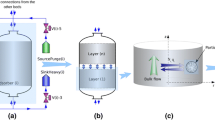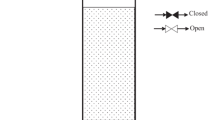Abstract
Mathematical models for pressure swing adsorption (PSA) processes essentially require the simultaneous solutions of mass, heat and momentum balance equations for each step of the process using appropriate boundary conditions for the steps. The key model input variables needed for estimating the separation performance of the process are the multicomponent adsorption equilibria, kinetics and heats of adsorption for the system of interest. A very detailed model of an adiabatic Skarstrom PSA cycle for production of high purity methane from a ethylene-methane bulk mixture is developed to study the sensitivity of the process performance to the input variables. The adsorption equilibria are described by the heterogeneous Toth model which accounts for variations of isosteric heats of adsorption of the components with adsorbate loading. A linear driving force model is used to describe the kinetics. The study shows that small errors in the heats of adsorption of the components can severely alter the overall performance of the process (methane recovery and productivity). The adsorptive mass transfer coefficients of the components also must be known fairly accurately in order to obtain precise separation performance.
Similar content being viewed by others
Abbreviations
- a :
-
Specific heat transfer area from adsorbent in differential kinetic test
- b i :
-
Interaction parameter of Toth isotherm equation
- b * i :
-
b i atT→∞
- C g :
-
Molar heat capacity of gas
- C s :
-
Heat capacity of adsorbent
- d p :
-
Particle diameter
- f :
-
Fractional uptake in differential kinetic test
- F :
-
Feed gas quantity per cycle in PSA process
- h :
-
External heat transfer coefficient in differential kinetic test
- k :
-
Parameter of Toth isotherm equation
- k i :
-
Adsorptive mass transfer coefficient for componenti
- L :
-
Column length
- m :
-
Saturation adsorption capacity of Toth isotherm equation
- n i :
-
Specific amount of componenti adsorbed
- P :
-
Pressure
- P/F :
-
Purge to feed gas quantity (actual volume)
- P P :
-
Purge gas inlet pressure
- P F :
-
Feed gas inlet pressure
- P D :
-
Final depressurization pressure
- Q :
-
Superficial molar flux through column
- q i :
-
Isosteric heat of adsorption of componenti
- q * i :
-
Pure gas isosteric heat of adsorption at Henry's Law region
- R :
-
Gas constant
- t :
-
Time
- T :
-
Temperature
- T 0 :
-
Reference temperature
- y :
-
Gas phase mole fraction
- z :
-
Distance in column
- z*:
-
z/L
- α :
-
Parameter in Eq. (13)
- β :
-
Parameter in Eq. (13)
- λ:
-
Parameter in Eq. (13)
- υ :
-
Parameter in Eq. (13)
- μ :
-
Gas viscosity
- ρ g :
-
Gas density (=P/RT)
- ρ s :
-
Adsorbent bulk density
- ϑ i :
-
Fractional adsorbate loading for componenti (=n i /g)
- ϑ :
-
Total fractional adsorbate loading (= Σϑ i )
- ε :
-
Total void fraction in column
- \(\frac{\varepsilon }{\varepsilon }\) :
-
Inter-particle void fraction in column
- D :
-
Desorption
- F :
-
Feed gas entrance conditions
- P :
-
Purge gas entrance conditions
- i :
-
Componenti
- *:
-
Equilibrium conditions
- o :
-
Pure gas
References
Ergun, S., “Fluid Flow Through Packed Columns,”Chem. Engr. Prog.,48(2), 89 (1952).
Hindmarsh, A.C., “ODEPACK, A Systematized Collection of ODE Solvers,”Scientific Computing, R.S. Stepleman et al. (Eds.), North-Holland, Amsterdam, 1983.
Hartzog, D.G., V.G. Fox, R. Kumar, Y.C. Chen, P.A. Houghton, and T. Naheiri, “A Versatile Process Simulator for Adsorptive Separations,” paper presented at AIChE Meeting in Miami, Florida, Nov. 1992.
Jaroniec, M. and J. Toth, “Adsorption of Gas Mixtures on Heterogeneous Solid Surfaces: Extension of Toth Isotherm on Adsorption from Gas Mixtures,”J. Colloid Polym. Sci.,254, 643 (1976).
Sircar, S., “Linear Driving Force Model for Non-Isothermal Gas Adsorption Kinetics,”J. Chem. Soc. Faraday Trans. I.,79, 785 (1983).
Sircar, S., and R. Kumar, “Equilibrium Theory for Adiabatic Desorption of Bulk Binary Gas Mixture by Purge,”I.&E.C. Proc. Des. Dev.,24, 358 (1985).
Sircar, S., “Pressure Swing Adsorption: Research Needs by Industry,”Fundamentals of Adsorption, Proceedings of the Engineering Foundation Conference held at Sonthofen, Germany, A.B. Mersmann et al. (Eds.), 815 (1991a).
Sircar, S., “Isosteric Heats of Multicomponent Gas Adsorption on Heterogeneous Adsorbents,” Langmuir,7, 3065 (1991b).
Skarstrom, C.N., “Method and Apparatus for Fractionating Gaseous Mixtures by Adsorption,” U.S. Patent 2,944,627 (1960).
Szepesy, L. and V. Illes, “Adsorption of Gases and Gas Mixtures, I,”Acta Chim. Hung.,35, 37 (1963a).
Szepesy, L. and V. Illes, “Adsorption of Gases and Gas Mixtures, III,”Acta Chim. Hung.,35, 245 (1963b).
Valenzuela, D., and A.L. Myers, “Gas Adsorption Equilibria,”Separation and Purification Methods,13, 153 (1984).
Author information
Authors and Affiliations
Rights and permissions
About this article
Cite this article
Hartzog, D.G., Sircar, S. Sensitivity of PSA process performance to input variables. Adsorption 1, 133–151 (1995). https://doi.org/10.1007/BF00705001
Received:
Revised:
Accepted:
Issue Date:
DOI: https://doi.org/10.1007/BF00705001




